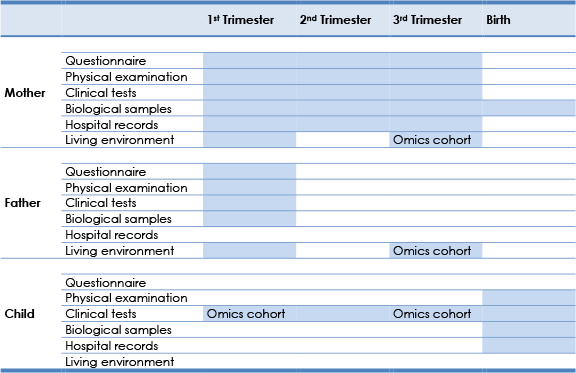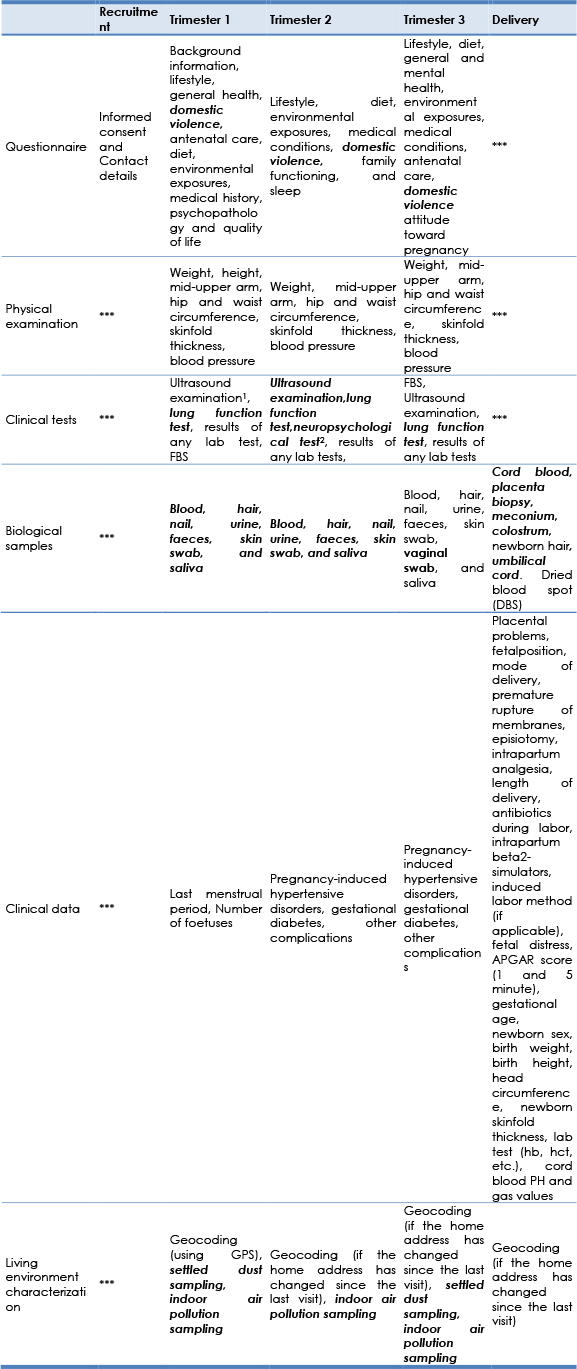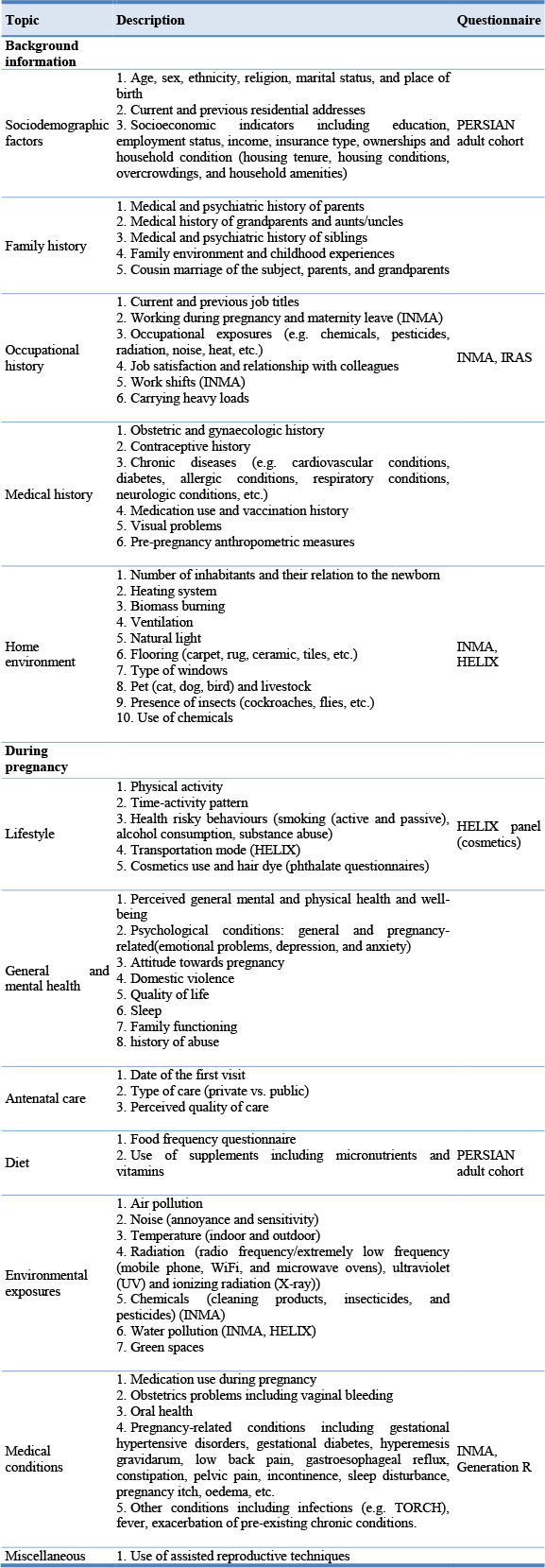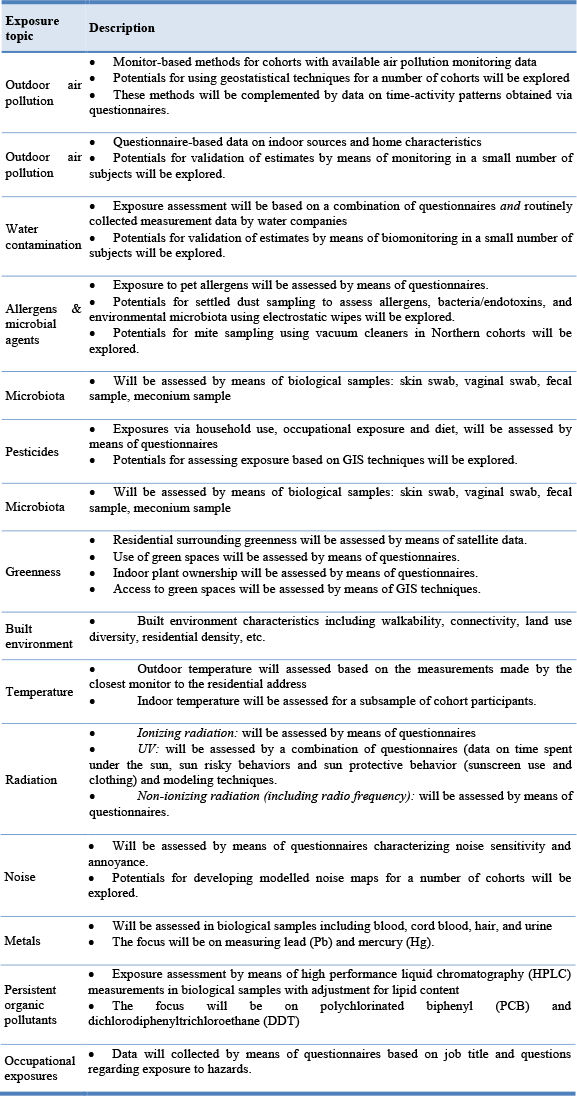Phase 1 Data collection design
Because of the costs and practical reasons, it will not feasible to collect all the desired data (as listed below) for all planned mother-child pairs in the cohort. Therefore, additional detailed data collection will be conducted in a selected subgroup of children and their parents from foetal life onwards.
A. General cohort:
a survey of 15,000 pregnant women across all designed centres for which we will collect data on:
- Physical examination (as described below)
- Questionnaires (as described below)
- Clinical tests (mother):
- Fasting blood sugar
- Ultrasound examination (Twice at first and third trimesters to assess foetal growth and gestational age)
- Clinical data (as described below)
- Biological samples
- Mother
- Blood (once)
- Urine (once)
- Hair (once)
- Nail (once)
- Skin swab (once)
- Faeces (once)
- Mother
- Living environment
- Geocoded home addresses
- Home characteristics (as described below)
B. Omics sub-cohort:
5000-7000 pregnant women selected from the general cohort for which in addition to the data mentioned above for the general cohort, we will collect data on
- Clinical tests (mother)
- Ultrasound examination (once each trimester to access foetal growth (the second trimester examination should occur around week 20), brain development and cerebral ventricular volumes, fetal umbilical artery and the middle and anterior cerebral arteries, and placental echogenicity and perfusion)
- Neuropsychological tests (once)
- Biological samples:
- Mother
- Blood (once per trimester and once at delivery)
- Urine (once per trimester)
- Faeces (once per trimester)
- Skin swab (once)
- Colostrum
- Saliva (once per trimester)
- Vaginal swab (once at the third trimester)
- Newborn
- Cord blood
- Placenta
- Umbilical cord
- Father
- Skin swab
- Living environment
- Home indoor environment sampling (as described below)
- Home surrounding environment (as described below)
- Settled dust (Twice at 1st and 3rd trimesters)
- Mother
Phase 1 data collection methods
We will collect data from the mother, father, and the child using questionnaires, biological samples, physical examinations, clinical tests, hospital records, and survey of the living environment as detailed in table 3. The tasks planned for each Phase 1 visit are detailed in Table 4. Table 5 describes the information planned to be collected through questionnaires. Table 6 details methods that will be applied to assess exposure to environmental factors.
Data collection for the mothers and children using questionnaires, biological samples, physical examinations, and clinical tests will be conducted in the PERSIAN cohort centres. In each PERSIAN cohort centre, a team consisting of a general practitioner, a nurse, and a psychologist will conduct face-to-face interviews with participants to fill the questionnaires (psychologist), physical examinations (GP), and obtain and process biological samples (nurse). Participants in phase 1 are pregnant women and their husbands. In phase 2, participants will be mother-child pairs and the father of the child who were enrolled in phase 1. At their visits to the PERSIAN cohort centres, the mothers will be asked to take self-administered questionnaires for the fathers and return the filled questionnaires in their next visit. The answers will be checked by PERSIAN cohort stuff and if the answers to some questions were missing, the participants will be called on the phone and will be asked to answer those questions (for details on the follow-up protocol see section...).
We will assign two full-time midwives to each participating hospital in order to obtain data from hospital records of the participants and collect biological samples at the time of birth. The home visits (for geocoding and characterizing the home environment) will be carried out by an environmental health technician. To enhance the compliance among the participants, it is advisable to recruit female staffs for all the aforementioned positions.
Table 3. Data collection methods and timeline during Phase 1.

Table 4. Tasks during each Phase 1 visits. Tasks with underlined fonts apply to both father and mother, those in bold fonts apply to child, and those in normal fonts only apply to mothers.

1 To determine gestational age, to monitor foetal growth, to determine mental development, and to evaluate placental echogenecity and perfusion
2 working memory, IQ, verbal skills
Table 5. Description of questionnaires used in Phase 1.

Table 6. Assessment of exposure to environmental factors.





